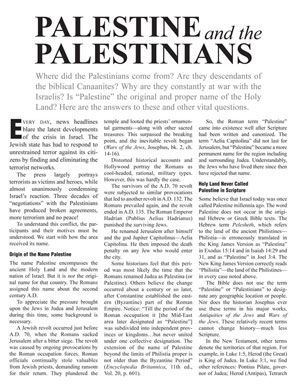Every day, news headlines blare the latest developments of the crisis in Israel. The Jewish state has had to respond to unrestrained terror against its citizens by finding and eliminating the terrorist networks.
The press largely portrays terrorists as victims and heroes, while almost unanimously condemning Israel’s reaction. Three decades of “negotiations” with the Palestinians have produced broken agreements, more terrorism and no peace!
To understand this conflict, the participants and their motives must be understood. We start with how the area received its name.
Origin of the Name Palestine
The name Palestine encompasses the ancient Holy Land and the modern nation of Israel. But it is not the original name for that country. The Romans assigned this name about the second century A.D.
To appreciate the pressure brought upon the Jews in Judea and Jerusalem during this time, some background is necessary.
A Jewish revolt occurred just before A.D. 70, when the Romans sacked Jerusalem after a bitter siege. The revolt was caused by ongoing provocations by the Roman occupation forces. Roman officials continually stole valuables from Jewish priests, demanding ransom for their return. They plundered the temple and looted the priests’ ornamental garments—along with other sacred treasures. This surpassed the breaking point, and the inevitable revolt began (Wars of the Jews, Josephus, bk. 2, ch. 14-16).
Distorted historical accounts and Hollywood portray the Romans as cool-headed, rational, military types. However, this was hardly the case.
The survivors of the A.D. 70 revolt were subjected to similar provocations that led to another revolt in A.D. 132. The Romans prevailed again, and the revolt ended in A.D. 135. The Roman Emperor Hadrian (Publius Aelius Hadrianus) punished the surviving Jews.
He renamed Jerusalem after himself and the god Jupiter Capitolinus—Aelia Capitolina. He then imposed the death penalty on any Jew who would enter the city.
Some historians feel that this period was most likely the time that the Romans renamed Judea as Palestina (or Palestine). Others believe the change occurred about a century or so later, after Constantine established the eastern (Byzantine) part of the Roman Empire. Notice: “Till the period of the Roman occupation it [the Mid-East area later designated as “Palestine”] was subdivided into independent provinces or kingdoms…but never united under one collective designation. The extension of the name of Palestine beyond the limits of Philistia proper is not older than the Byzantine Period” (Encyclopedia Britannica, 11th ed., Vol. 20, p. 601).
So, the Roman term “Palestine” came into existence well after Scripture had been written and canonized. The term “Aelia Capitolina” did not last for Jerusalem, but “Palestine” became a more permanent name for the region including and surrounding Judea. Understandably, the Jews who have lived there since then have rejected that name.
Holy Land Never Called Palestine in Scripture
Some believe that Israel today was once called Palestine millennia ago. The word Palestine does not occur in the original Hebrew or Greek Bible texts. The Hebrew term Pelesheth, which refers to the land of the ancient Philistines—Philistia—is erroneously translated in the King James Version as “Palestina” in Exodus 15:14 and in Isaiah 14:29 and 31, and as “Palestine” in Joel 3:4. The New King James Version correctly reads “Philistia”—the land of the Philistines—in every case noted above.
The Bible does not use the term “Palestine” or “Palestinians” to designate any geographic location or people. Nor does the historian Josephus ever use these terms in his major works, Antiquities of the Jews and Wars of the Jews. These relatively recent terms cannot change history—much less Scripture.
In the New Testament, other terms denote the territories of that region. For example, in Luke 1:5, Herod (the Great) is King of Judea. In Luke 3:1, we find other references: Pontius Pilate, governor of Judea; Herod (Antipas), Tetrarch of Galilee; Philip, Tetrarch of Ituraea (northeast of Judea); and Lysancas, Tetrarch of Abilene (near Ituraea). Notice that there is no “king,” “governor” or “tetrarch” of Palestine found anywhere in Scripture—more proof that “Palestine” was not an ancient term.
Secular History Finds “Palestine” Without Merit
Notice the following: “PALESTINE, a geographical name of rather loose application. Etymological strictness would require it to denote exclusively the narrow strip of coastland once occupied by the Philistines, from whose name it is derived…The modern subdivisions under the jurisdiction of the Ottoman Empire are in no sense conterminous [having common boundaries] with those of antiquity, and hence do not afford a boundary by which Palestine can be separated exactly from the rest of Syria in the north, or from the Sinaitic and Arabian deserts in the south…” (Encyclopedia Britannica, 11th ed., p. 600).
These historians strongly imply that (1) the boundaries are obscure, (2) the territorial name breaks many ancient language rules, and (3) at best, the name is a “loose application.” (The boundaries were in effect in 1910, when this source was written. The Ottoman Empire still controlled the region, and Judea was designated as part of Syria.)
In short, by God’s standards, the term “Palestine” is illegitimate. (This will be covered later.) To name the entire region in honor of the Philistines—bitter enemies of Israel for centuries—insults the Jews. The Romans chose this name because they knew it would be an abomination to the Jews. For these reasons, some informed political leaders and statesmen still denounce the term “Palestine.” One of the more notable is Lady Margaret Thatcher (former prime minister of Britain), one of the few public figures not intimidated by “political correctness.”
The Peoples of the Mid-East
While they were still in Egypt, God revealed to Israel how they would obtain the land of Canaan—the Promised Land: “And I am come down to deliver them [Israelites] out of the hand of the Egyptians, and to bring them up out of that land unto a good land and a large [land], unto a land flowing with milk and honey; unto the place of the Canaanites, and the Hittites, and the Amorites, and the Perizzites, and the Hivites, and the Jebusites” (Ex. 3:8).
These peoples, as far as lineages can be traced, were descendants of Ham. Collectively, they were called Canaanites, and the land was often referred to as Canaan (Gen. 10:15-20).
Palestinians today insist that they inhabited the land of Canaan before God gave it to Israel. But they are either seriously misinformed or willfully ignorant. The Canaanites described above were definitely not of Arab descent. The Arabic peoples are descendants of Ishmael, who descended from Shem. The peoples of Tunisia, Malta, Algeria and Sicily of today are of similar descent as these Canaanites.
The peoples who now call themselves Palestinians correctly acknowledge the common ancestry of Abraham, just as the Jews and Arabs claim.
Let’s review some of this tribal lineage to better understand the origin of the Jews and Arabs.
Abraham had two sons: Isaac (by his wife, Sarah) and Ishmael (by Hagar, her handmaid). Though Abraham passed the birthright to Isaac, Ishmael was also blessed, becoming the progenitor of the Arabs. Twelve princes, sons of Ishmael (Gen. 25:16), went on to form major Arab nations—not insignificant nomadic tribes. These peoples intermarried primarily with the Egyptians and were located south of Canaan, known as Arabia.
Isaac had two sons: Jacob and Esau. Abraham and Isaac’s God-given birthright was passed on to Jacob. Esau, like his uncle Ishmael, was also blessed with wealth and offspring. He moved away from Canaan to a region called Mount Seir, just south of the land of Moab (southeast of the Dead Sea). Esau was also called Edom, and his offspring were known as Edomites. Many rulers, nobles and kings were borne of Esau (Gen. 36). Esau married Mahalath, the daughter of Ishmael (Gen. 28:9). He also had a number of wives from various other nations. His offspring continued to marry into the families of Ishmael, as well as other peoples.
Meanwhile, Jacob, whose name God changed to Israel, had twelve sons—Reuben, Simeon, Levi, Judah, Zebulon, Issachar, Dan, Gad, Asher, Naphtali, Joseph and Benjamin—the twelve tribes of Israel. While in Egypt for nearly two and a half centuries, the tribes of Israel grew vastly in numbers. The birthright was passed from Jacob (or Israel) to Joseph’s sons, Ephraim and Manasseh. Israel effectively became thirteen tribes. The birthright remained with Ephraim and Manasseh, and began to be fulfilled in about A.D. 1800.
Israel and Judah
After the time of King Solomon, Israel split into two nations: Judah and Israel (to the north of Judah). Judah consisted of the tribes of Judah and Benjamin, as well as the majority of Levi. These peoples became known as Jews. In fact, the Bible’s first use of the word “Jews” is in II Kings 16:6, when the Jews (allied with Syria) were at war with Israel.
The northern ten tribes of Israel were taken captive by the Assyrians in 721-718 B.C. and became known as the “lost ten tribes of Israel.” The Jews remained in the land of Judah (later Judea). The Assyrians placed other peoples in the land formerly inhabited by the ten tribes. Transplanted from a region near Babylon, these new inhabitants were called Samaritans.
In about 600 B.C., the Jews were taken captive by the Babylonians. A remnant of them returned approximately 70 years later. The vast majority of the Jews remained dispersed among other nations after the captivity. The Jews who returned faced continual opposition by certain peoples, such as the Samaritans and the peoples of Ammon and Moab. The Ammonites and Moabites—sons of Lot, Abraham’s nephew—were distant relatives of the Jews. The Jews’ most bitter rivals were none other than the Edomites—sons of Esau.
Later, as Alexander the Great’s Empire dominated the region, such local rivalries were suppressed. The series of ongoing wars between the Seleucid and Ptolemy Empires—fragments of Alexander’s former Empire—dominated the second century B.C.
Next came the Roman era and their provocation of the Jewish religious leaders, as mentioned earlier.
The Masses of Palestine
Major population shifts occurred in the area before the Jews’ arrival between 1917 and 1948: “The spread of Islam introduced a very considerable Neo-Arabian infusion. Those from southern Arabia were known as the Yaman tribe, those from northern Arabia the Kais (Qais). These two divisions absorbed the previous peasant population, and still nominally exist [as of 1910]; down to the middle of the 19th century they were a fruitful source of quarrels and of bloodshed.” (Encyclopedia Britannica, 11th ed., Vol. 20, p. 604). Note that these people were inclined toward quarreling and infighting.
The “infusion” of Arabians coincided with the expansion of Islam. Their presence in the Holy Land began about the seventh century A.D. These waves of migration continued as the Turks pushed north, and west, spreading Islam by the edge of the sword. By the tenth century A.D., the Turks had conquered the former land of Judea, as well as Jordan, Syria, and Lebanon. By the eleventh century, they controlled the bulk of Asia Minor. The Arabians—descendants of Ishmael as well as Esau—claimed the land from that time until the present.
Many of the particular nationalities that live in Judea and Jerusalem do not intermix and intermarry with other peoples or nationalities.
Notice this reference about the Samaritans: “The most interesting of all the non-Arab communities in the country, however, is without doubt the Samaritan sect in Nablus (Shechem); a gradually disappearing body, which has maintained an independent existence from the time they were first settled by the Assyrians to occupy the land left waste by the captivity of the kingdom of Israel” (Ibid.).
Like the Samaritans, the original Canaanite nations and the Philistines also diminished in size and had long since emigrated. Much of this occurred during the time of David and Solomon. An example is the Hivites, who were “hewers of wood and drawers of water” (Josh. 9:21). “And all the people that were left of the Amorites, Hittites, Perizzites, Hivites, and Jebusites, which were not of the children of Israel, their children that were left after them in the land, whom the children of Israel also were not able utterly to destroy, upon those did Solomon levy a tribute of bondservice unto this day” (I Kgs. 9:20-21).
Modern descendants of these former bond servants exist only in occasional lineages of certain modern inhabitants of the nation of Israel. The percentage of that bloodline would only be small, being diluted by many generations.
Arabs comprise the bulk of the remaining residents. Not only did the term “Palestine” originate as late as the Byzantine era, the Arabs who call themselves “Palestinian” did not lay claim to the Holy Land until about the tenth century A.D.
Relatively few Arabs were in the region when the Jews returned in 1917. Shortly before then, the population of the Holy Land was estimated at about 650,000 permanent residents. More than 65% were Islamic (Ibid.). Only after the Jews established their nation in 1948 did the masses of these Arabic peoples feel drawn to this particular territory. The population of Palestinians swelled dramatically after the Jews brought about vast improvements in agricultural production. They established irrigation and re-introduced efficient means of agriculture.
Understandably, many took advantage of gainful employment provided by the Jews in developing the land and building a needed infrastructure for the tiny nation of Israel. These local laborers were called fellahin, or agricultural workers. Previously, the Arabs had only used primitive methods. Without the innovations introduced by the Jews, the fellahin had been restrained by their own superstitions, which prohibited advancements and efficiency in agriculture. So, initially, a mutual benefit existed, and the two peoples worked together.
But the Jews were never welcomed by Arab leaders who harbored jealousy and ancient resentment. No consideration was given to the willingness of the Jews to advance the cause of the fellahin.
Golda Meir, former Prime Minister of Israel, offered some insightful comments on this. Herbert W. Armstrong, a friend and confidant of Mrs. Meir and many other Middle Eastern leaders, recorded her words in 1971. Keep in mind that these statements followed the 1967 War:
“Then she told us of the Israelis’ ability and willingness to help their Arab neighbors. This small but remarkable nation now sends its experts and its technology throughout the deepest parts of Africa and to even more remote places in the world to help under-developed nations.
“‘How easy it would be,’ she said earnestly, ‘to send the same teams across the border into Jordan, or across the canal into Egypt, and how much prosperity and happiness would be brought to this entire area of the world by peace...
“‘We don’t want to have to go on winning more and more victories,’ she added. ‘We only want peace...’”
Then Mr. Armstrong reflected upon Mrs. Meir’s words: “What a deplorable tragedy that the whole world cannot now have the kind of peace, with prosperity and happiness that Prime Minister Golda Meir expressed a desire for—each nation cooperating with its neighbor.
“But the reason is summed up in the biblical statement: ‘The way of peace they know not.’ There has, of necessity, to be a cause for every effect. There will have to be a cause to produce peace. That cause is a way of life” (Autobiography of Herbert W. Armstrong, Vol. 2, pp. 500-501).
Today, Palestinian leaders and Islamic clerics have rejected gestures of mutual cooperation from the Jews, because their ancient hatreds stand in the way. Their only plan regarding Israel is nothing less than the extinction of all Jews.
Ownership of the territory is another controversial issue. The Palestinians claim to be the ancient owners of Palestine. Yet we see that they only took possession of the land in the wake of the Turkish campaign through that region in about the tenth century A.D. The claim made by ancient Israel precedes this claim by about 2,300 years.
How ironic that these Palestinians accuse the Jews of depriving them of their home when (1) the vast majority of them moved to Israel after the Jews reclaimed the land from desolation and ruin, and (2) their Arab relatives in the world of Islam own over 1,000 times more real estate than exists within the boundaries of tiny Israel. Remember when thousands of Palestinians were expelled from Kuwait in 1991 after they were found conspiring with the Iraqis in selling out their host country?
The following scriptures show how the true Owner of this and all land everywhere expressed this “land transfer”: “And the Lord gave unto Israel all the land which He swore to give unto their fathers; and they possessed it, and dwelt therein. And the Lord gave them rest round about, according to all that He swore unto their fathers: and there stood not a man of all their enemies before them; the Lord delivered all their enemies into their hand. There failed not ought of any good thing which the Lord had spoken unto the house of Israel; all came to pass” (Josh. 21:43-45).
Joshua 24:13 covers more details: “And I [the Lord] have given you a land for which you did not labor, and cities which you built not, and you dwell in them; of the vineyards and oliveyards which you planted not do you eat.”
The Coming Solution
Today, the Islamic Arabs (descendants of Ishmael and Esau) bear the same rivalry and suspicion of the Jews that they have always borne for Israel. But that rivalry is greatly intensified by Islamic fundamentalists advocating the destruction of the Jews and Israel. The most dangerous enemy of the west—as well as the Jews—is the incessant Islamic message that fuels the flames of hatred and vengeance, which fuels the fires of terrorism.
The Palestinians have lived near the Jews for over half a century. This closeness to the “enemy” makes them of great value to the perpetuators of terrorism. Thus, the Palestinians have served as surrogates for the states who sponsor terrorism, namely Syria, and Iran, confronting the Jews with escalating terrorism, at every opportunity.
To see through the smoke surrounding the Mid-East crisis, a clear understanding of Palestine and the Palestinians is critical. We live in momentous times. Events in this crucial area will soon impact everyone!
This millennia-old hatred will soon come to a boil, instigated by the “god of this world,” Satan the devil (II Cor. 4:4). He is the source of human nature, the source of all wars, evils, and mass confusion: “From whence come wars and fightings among you? Come they not hence, even of your lusts that war in your members? You lust, and have not: you kill and desire to have, and cannot obtain: you fight and war, yet you have not because you ask not. You ask, and receive not, because you ask amiss, that you may consume it upon your lusts” (Jms. 4:1-3).
Satan is the great deceiver; so great that most do not believe that he even exists (Rev. 12:9). (Read our free booklets Who Is the Devil?, A World in Captivity, and Did God Create Human Nature?, to learn more.)
Real peace—the kind that lasts forever—will not come before the end of this age. (For more information read our free booklet How World Peace Will Come!. You will find this to be an incredible eye-opener.) The present dilemma will not be solved until the arrival of the King of Peace—Jesus Christ—and the kingdom of God.






















